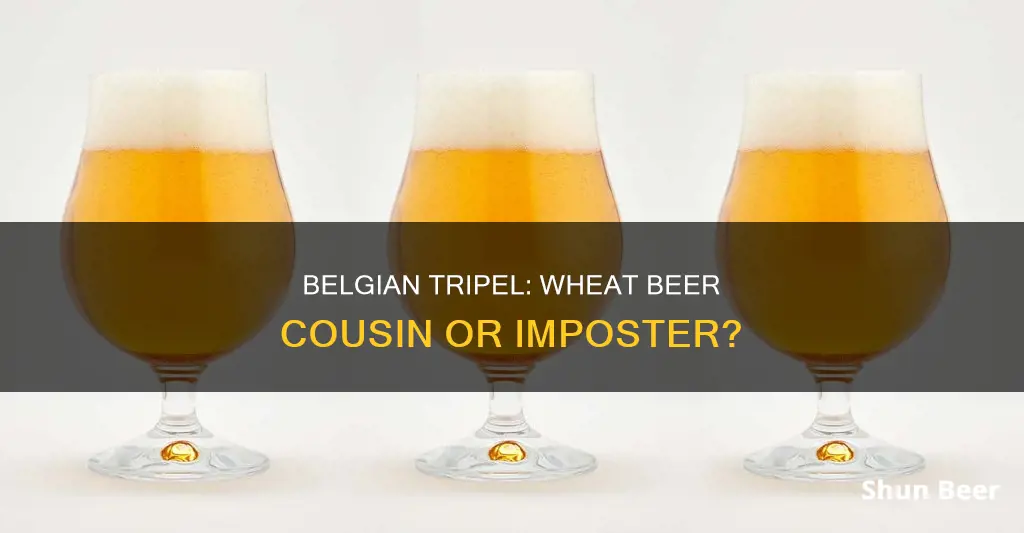
Belgian Tripel is a style of beer with roots in the Belgian Trappist beer tradition. The name tripel is a nod to the stronger alcoholic content in this style of beer. The term tripel comes from the Low Countries (now the Netherlands and Belgium) and was first used in 1956 by the Trappist brewery, Westmalle, to rename the strongest beer in their range. Tripels are often on the higher end of the ABV spectrum, ranging from 7-10% ABV, and are characterized by a complex, sometimes mildly spicy flavor profile. They are usually clear, ranging in color from pale yellowish-gold to dark copper, and have a dense and creamy off-white head. While the origin of the term tripel is unknown, one theory suggests that it indicates strength, either through a series of marks on a cask or by reference to the original gravity of the beer.
What You'll Learn

Belgian Tripel is a strong ale
The Belgian Tripel is a strong ale, born in the early 1930s from the genius of secular brewer Hendrik Verlinden of the Drie Linden brewery. It is a style with roots in the Belgian Trappist beer tradition, with the name "tripel" generally used for the strongest beer in a monastery's repertoire. The term likely comes from the series of marks, such as crosses, used to indicate the strength of the beer on a cask, with XXX denoting the strongest beer.
Belgian Tripels are strong golden ales, typically ranging from 7-10% ABV, and are characterised by their complex mix of malts, fruits, spices, and alcohol flavours. They are often bottle-conditioned and have a dry finish. The colour ranges from pale yellowish-gold to dark copper, and they have a dense and creamy white head. The aroma is complex, with a light malt profile, moderate to high spiciness, light alcohol tones, and fruit esters, particularly citrus fruits like orange and lemon, and banana. The high alcohol content adds a creaminess to the medium-light to medium body, and it remains lighter and more effervescent than expected for its high alcohol content.
The grain bill for a Tripel can be very simple, with the bulk of any recipe made up of high-quality Pilsner malt. However, some recipes may include a small addition of character malt, such as light crystal, aromatic, light Munich, or malted grains like wheat or oats. Adjunct sugar is always used, contributing to the high ABV and the crisp, mellow lightness of the beer. A good Belgian yeast is essential, adding qualities of spice and hints of banana, lemon, and orange. The bitterness is typically in the range of 30-40 IBUs, and the beer is highly carbonated.
The Belgian Tripel is a challenging style to brew well, but the best examples find harmony through restraint, with complexity that drinks like a weaker, simpler beer.
Landshark Beer: Is It Safe for Wheat Allergies?
You may want to see also

It is not a wheat beer
A Belgian Tripel is not a wheat beer. While the name "tripel" may suggest that something in the beer comes in threes, this is not the case. The name is simply a nod to the stronger alcoholic content of this style of beer. The term "tripel" likely originated from the Low Countries (now the Netherlands and Belgium) and was used to indicate strength. One theory is that the number of Xs marked on a cask corresponded to the strength of the beer, with three Xs for the strongest beer.
Belgian Tripel is a style of strong, pale ale, with a golden hue, that was first brewed in the early 1930s. The style was popularised by the Trappist monks of Westmalle Abbey, who released their own Tripel beer in 1956. The recipe has remained unchanged since then and is considered the standard for this style of beer.
Belgian Tripels are characterised by their high alcohol content, typically ranging from 7% to 10% ABV. They have a complex flavour profile, with notes of orange citrus, subdued banana, spice, and floral hops. The yeast used in the brewing process plays a significant role in the final product, imparting spice, banana, lemon, and orange flavours. The high alcohol content adds creaminess to the mouthfeel, making it lighter and more effervescent than expected for a high-ABV beer.
While wheat beers, such as witbier, also exist within the realm of Belgian brewing, they are distinct from Belgian Tripels. Wheat beers, also known as white beers or bière blanche, have a history that dates back to the Middle Ages. They are typically tart, light in body, and moderate in alcohol content, usually ranging from 4.5% to 5.5% ABV. Wheat beers are brewed with unmalted wheat, coriander, and orange peel, resulting in a refreshing beverage with a pleasant balance of citrusy and spicy flavours.
Space Dust IPA: Wheat-Based Beer Mystery Solved
You may want to see also

It is a beer style with roots in the Belgian Trappist tradition
Belgian Tripel is a beer style with roots in the Belgian Trappist tradition. The Trappist beer tradition dictates that beer must be brewed by a protected and certified order of abbey monks. These breweries are not commercial ventures; instead, sales cover the monks' living expenses and the upkeep of the buildings and grounds. The typical Trappist beer lineup would consist of a Single, Dubbel, and Tripel, with Tripel being the strongest beer. The name "Tripel" is thought to refer to the strength of the beer, with casks traditionally marked with three Xs to indicate the strongest beer in a monastery's repertoire.
The Belgian Tripel style was born out of the desire to compete with the pale lagers of Germany that were becoming increasingly popular in Belgium during the 1920s. Brewing scientist and yeast specialist Hendrik Verlinden of Drie Linden Brewery is credited with creating the first Tripel, released around 1932 under the name "Witkap Pater," which eventually became "Witkap Tripel." Verlinden had consulted for Westmalle, a Trappist brewery in Belgium, and his beer was marketed as a Trappist beer. The monks at Westmalle continued to refine the recipe, and in the 1950s, they renamed their strongest beer "Tripel", solidifying the style and the name.
Belgian Tripels are typically strong golden ales with an ABV ranging from 7% to 12%. They are characterized by a complex, sometimes mildly spicy flavor, with yeast-driven complexity and a noticeable malt sweetness. Tripels are commonly bottle-conditioned, resulting in a refreshing carbonation and a dry finish. The key to a Belgian Tripel is to be highly drinkable, despite its high alcohol content and complex flavor profile.
Wheat Beer: Healthy Choice or Just Hype?
You may want to see also

It is a strong, pale ale
Belgian Tripel is a strong, pale ale. It is a style of beer that emerged from the Belgian Trappist brewing tradition. The term "tripel" refers to the strength of the beer, which is typically higher in alcohol content and has a more pronounced ABV, ranging from 7% to 12%. The name "tripel" is derived from the practice of marking barrels with X's to indicate strength, with three X's representing the strongest beer.
The key characteristics of a Belgian Tripel include its pale or golden colour, medium to full body, lively carbonation, and aromas. The flavour profile can range from spicy to fruity to floral, with a delicate and dry finish. The complexity of the beer comes from the yeast, and it often has a subtle banana and orange citrus taste with a slightly bitter aftertaste.
Belgian Tripels are bottle-conditioned, which means they undergo a secondary fermentation in the bottle, contributing to their carbonation and flavour development. The beers typically have a higher ABV, but they remain approachable to many different palates due to their balanced flavour profile.
The style was popularised by the Trappist brewery of Westmalle in the mid-20th century when they renamed their strongest beer "Tripel". The origin of the term "tripel" is unknown, but it is believed to indicate strength in some way, whether through the marking of casks or the original gravity of the beer.
Belgian Tripels are versatile in food pairings due to their complex and varied flavour profiles. They can complement spicy dishes like Cajun or Thai food, BBQ, roasted vegetables, or a cheese plate.
Wheat Beers: Hoppy or Not?
You may want to see also

It is not as old as other Belgian beers
Belgian Tripel is a style of beer with roots in the Belgian Trappist beer tradition. The name "Tripel" comes from the Low Countries (now the Netherlands and Belgium), and it is believed to indicate strength in some way. The two main theories are that it refers to a series of marks on a cask, such as crosses, or that it corresponds to the original gravity of the beer. While the exact origin of the term is unknown, it is generally agreed that it signifies a stronger beer.
The Belgian Tripel style is relatively young compared to other Belgian beers. It was born in the early 1930s, less than 85 years ago, through the work of secular brewer Hendrik Verlinden of Drie Linden brewery. Verlinden developed a recipe for a strong golden ale to compete with the rising popularity of pale beers in Europe. He released it under the name Witkap Pater in 1932, and it was later renamed Witkap Tripel. Verlinden was not a monk himself, but he had connections to the Westmalle Abbey and marketed the ale under the Trappist name.
The Westmalle Abbey introduced its own Tripel a couple of years after Verlinden's creation. Their recipe has remained unchanged since 1956 and is considered the standard for Belgian Tripels. The popularity of the style has grown in recent years, with various Trappist monasteries, abbeys, independent brewers, and even American microbreweries experimenting with Tripels and other Belgian styles.
While Belgian Tripel has a shorter history compared to some other Belgian beers, it has become an integral part of Belgium's high art of brewing. The style is known for its strong, golden ale, complex flavours, and high alcohol content, making it a favourite among beer enthusiasts.
German Wheat Beers: Sweet or Not?
You may want to see also
Frequently asked questions
A Belgian Tripel is a strong, pale ale with a complex, sometimes mild spicy flavour. It is bottle-conditioned and has a dry finish.
No, a Belgian Tripel is not a wheat beer. Wheat beers are typically brewed with wheat, as the name suggests, and are usually tart, light in body and moderate in alcohol content. Belgian Tripels are made from a simple grain bill, with the bulk of any recipe made up of high-quality Pilsner malt.
The ABV of a Belgian Tripel is typically between 7-10%, but can be as high as 12%.
The origin of the name "Tripel" is a matter of debate. One theory is that it refers to the strength of the beer, with barrels traditionally marked with Xs to indicate strength, so three Xs would indicate a Tripel. Another theory is that it refers to the relative gravity of a given wort.







